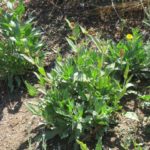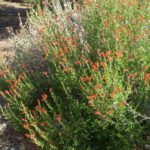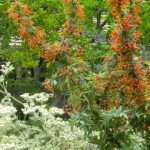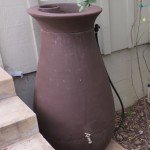Note: RSABG in Claremont CA has a free talk on Dec 17, 10-11am on “How to Water and Plant Native Plants”
After a baking hot summer in SoCA and no precipitation, we’ve revisited our previous planting and watering schedule. We’re still happy we went with mostly California native plants, but it’s always good to keep learning – therefore the following ‘Lessons Learned’.
Native Plants Need Some Water
Spurred on by an excellent publication “Watering Native Plants” by Tree of Life Nursery, we’ve learned the following about this challenging area of growing natives. I’ve had more people say they’ve killed every manzanita they’ve planted or that the watering aspect scares them most. Read the above document; meanwhile, here are our takeaways.

We put a hose on our 65- gal Cascata rainbarrel to water trees and our landscaping (so make sure all the rain water possible is going to the plants – our help with this.) And — water extra in winter if rains are slim. Rain is best! (so make sure all the rain water possible is going to the plants – our rain barrels help with this.) And — water extra in winter if rains are slim. I do think our landscaping got well established in 2009-10 because we got above-normal rain that year.
- Native plants need occasional deep watering year-round, particularly with this ongoing drought. We are watering our native landscaping, most of which is 8 years old, at least once a month by hand.We water on cooler mornings or late in the day, and let the water soak in deeply.Do NOT water during the heat of the day – I’ve killed more plants doing that.
- Avoid watering the crown and main stem, because native plants are sensitive to root rot and the idea is to water so the root zone expands outward and downward. In reflection, we think all our manzanitas have thrived b/c we watered them in winter but didn’t water them at all after the first couple summers. However, the watering of the plants next to them watered their expanding root zone.
- See my follow-up post on watering and planting natives for more info.
But… an aside – Don’t Overwater your Veggies
I’ve talked to many people whose tomatoes, squash and other plants suddenly died during the high heats. Well, mine did too. The problem – overwatering, especially right around the stem. Like all plants and trees, remember to replicate how rain would hit the soil – around the drip line of the plant.
Design Tip – Plant in Groupings

We wish we had done a better job of this, and we see too few people using the important design concept of planting in groupings. Instead of planting with equal spacing, planting in groups of threes or fives is more pleasing. This is also how plants grow in nature.
Choose plants for year-round color

In your planning, choose some plants which will provide blooms year-round, especially late summer through early fall – such as California fuchsias or anisacanthus (desert honeysuckle which we’ve gotten at the Desert Museum in Palm Desert) which goes deciduous in winter but is full of flowers the rest of the year. For other ideas – here’s a previous article California Native Plants with Sumer Color
Water your Trees
Even we didn’t realize the two trees in our former lawn – a magnolia and a non-fruiting plum tree – needed much more water. Please – if you take out lawns or thirstier plants, water your trees, which are especially suffering in the drought. Here’s an article Watering Trees during the Drought on this important subject.

Upcoming Fall Native Plant Sales
Fall through early winter is the time to plant natives! Plan now and buy…
Sat, Oct 1: Rancho Santa Ana Botanic Fall Planting Festival – Always a fantastic selection – members can attend two hours early 0n this one-day event (good talks too)
Sat-Sun, Oct 22-23: UCR Fall Plant Sale – this large plant sale always has a good selection of natives
Th-Sat, Oct 27-29: Theodore Payne Plant Sale – The Theodore Payne Foundation is in Sun Valley and features wildflowers and native plants
Sat, Nov 5: San Bernardino CNPS Plant Sale – this local chapter of the California Native Plant Society offers a good selection and knowledgeable help
Resources/For more info:
- Anyone who lives locally and wants to come visit our place and see how our plants have done – just contact me at [email protected]
- My favorite native plants for this summer heat
- Where to buy natives in the inland empire? – I recommend Mockingbird Nursery, Louie’s Nursery (Riverside), Parkview Nursery (Riverside), Cherry Valley Nursery (Cherry Valley) and for the biggest variety – Rancho Santa Ana Botanic Garden (Claremont)

Leave a Reply